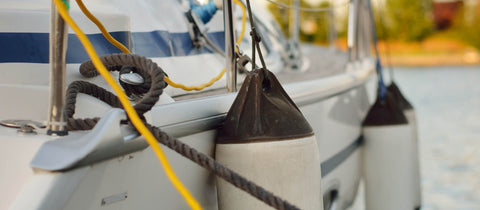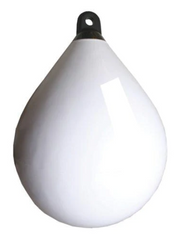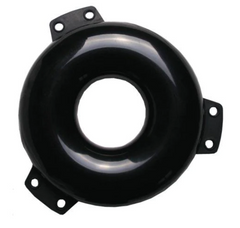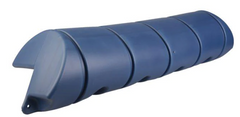CHOOSING THE RIGHT BOAT FENDERS
Selecting the right size and type of fenders to protect your boat
What do Fenders do?
Fenders are cushions that prevent a boat from being damaged by rubbing or impacting a dock (concrete, metal, or wood) when the boat's tied up, or from contact with another boat when multiple boats are tied/rafted together.
Different types of boat fenders
There are three main types of fenders, and their use depends on the size of your boat, the docking situation at hand, and other extenuating circumstances.
Vinyl fenders
- These are the most common and can be purchased at any chandlery store
- They come in many sizes and colours.
- They are typically cylindrical and inexpensive but when large, can be heavy.
- They make up the bulk of the fenders you’ll see in a marina and are used mostly by small craft like sailboats, bowriders, and pontoon boats.
Foam fenders
- These come in different shapes, often flat, so they don’t take up much room in a tight slip.
- They’re hard to store, especially when they’re large and they’re expensive. Note: foam can disintegrate over time polluting the water and marking your hull.
Inflatable fenders
- These are made of various materials including PVC
- Due to the ability to deflate them for storage, even large ones can be accommodated aboard.
- They’re typically lightweight and strong but quite expensive.
- Most of these are used by larger vessels that travel long distances and need to store them easily.
What style do you prefer?
|
Ball Fenders or Round Fenders are spherically shaped, which like the long fender are inflated with air and constructed out of tough PVC material with a strongly reinforced single eyelet. The ball fender has excellent point-of-impact protection and like the centre-cored long fender, easily rolls to move the point of contact along with the hull. Ball fenders are often used while manoeuvring through tight spaces or while going in and out of locks. The ball fender has excellent point-of-impact protection and like the centre-cored long fender, easily rolls to move the point of contact along with the hull. Ball fenders are often used while manoeuvring through tight spaces or while going in and out of locks. They are often called "standby fenders.” They are also very versatile and can be used to mark an anchor location or to float a temporary pick-up line. They are popular for larger powerboats with concave bows and larger commercial vessels (especially commercial fishing boats). Orange round fenders are also used as low-tech mooring buoys. |
|
|
Bow Fenders are incredibly versatile, flexible fenders. They are designed to offer maximum protection to the bow of your boat while looking as discrete as possible. The bow fender attaches to the boat using ropes through the top and bottom sections of the fender. |
|
|
Drop Fenders or Long Fenders or sometimes referred to as “walking fenders”, are the most common type of fender. The primary reason for its popularity is its ease of handling and the ability to deploy it either vertically or horizontally, from cleats, railings, or lifelines - depending on the size of the vessel. SVB offers a wide selection of both the two-eyed long and the centre-core long fender types, depending on your individual needs or preferences. The most common reason for choosing the centre cord long fender is its ability to be used during frequent docking situations, where more roll is needed, in order to bring the boat up alongside the dock. Both types of long fenders offer two attachment points for horizontal placement when needed. |
|
|
Star Fenders or Two-Eye Cylindrical Fenders have a moulded-in fairlead or tab at each end. Tie a line to one end only and hang the fender vertically or tie both ends for horizontal deployment.
|
|
|
Step Fenders provide that bit of extra protection while also giving you an easy step onto and off of your boat. The Fender Step has solid eyes for strength. The fender inflates to about 24cm, wide enough to put your whole foot on. |
|
|
Ring Fenders are used for anchor pipe or marking anchor line position. |
|
|
Dock Fenders are used at ports and docks on quay walls and other berthing structures. They absorb the kinetic energy of a berthing vessel and thus prevent damage to the vessel or the berthing structure. There are 2 major categories of fenders for port applications: Fixed and Floating. |
|
|
Flat Fenders are square which keeps them from sliding or rolling around. Made from closed-celled materials they are used to protect your boat from damage, from other boats, or a marina berth or dock wall. |
|
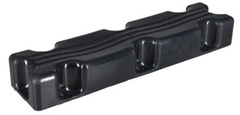 |
Pontoon Fenders are available in specialized shapes. They protect the delicate aluminium fencing and unusual corners on pontoon boats. |
Fender Size Guide
Choosing the right size fender
Consider these factors when selecting the appropriate size for your fenders: Yacht Length Overall, Yacht Displacement (weight), and the anticipated mooring conditions.
There is an old-fashioned rule of thumb that will give you a starting point before making a final decision based on these three main factors.
Rule of Thumb 1 = 1-inch fender diameter or 2-inch round fender diameter for every 4 or 5 feet of yacht length overall.
Frequency Guide
There is another old rule of thumb for this as well.
Rule of Thumb 2 = 1 fender per 10 feet of Low Waterline Length (LWL) with a minimum of 3 for boats of 20 feet or less. The rule has been developed into a modern metric measure equivalent.
What size fender do I need?
|
Boat Length In Feet |
Cylindrical Fender Diameter |
Round Fender Diameter |
Flat Fender Size |
|
Under 10' |
3" |
NR |
Small |
|
10'–15' |
3"–4" |
9" |
Small |
|
15'–20' |
5"–5.5" |
12" |
Small |
|
20'–25' |
6"–6.5" |
15" |
Medium |
|
25'–35' |
8"–8.5" |
18" |
Medium |
|
35'–50' |
10.5"–12" |
21" |
Large |
|
50'–60' |
12" |
27" |
Large |
|
60'–72' |
15"–24" |
27" |
Large |
How to set up boat fenders
Fenders need to be positioned properly, paying due care and attention to the spacing and height of the fenders and assessing what proportion should be round/ball rather than cylindrical/long fenders.
Install at least one fender from the centre (maximum beam), with the remainder, spaced appropriately before and after from the centre outward.
When mooring alongside another boat, an extra fender or two amidships will be required for adequate protection. An additional round fender positioned before and after will help to fill the increased gap between the topsides.
Hang fenders so they are always clear of the water or even higher when required by the pontoon height. Secure the fender ropes to strong, deck-level anchorage points. Avoid using lifelines or guard wires if possible because they are not designed to withstand the potential stresses and strains. A lower attachment point maintains the fender in position better by lessening the arc or swing.
Fender Accessories
 |
Fender Socks keep your fenders from getting dirty. Some boats have theirs embroidered with the boat’s name for a very posh accent. |
 |
Fender Baskets allow you to store one or two fenders on the lifeline stanchion’s 7/8" or 1" tubing, so they’re ready for deployment. |
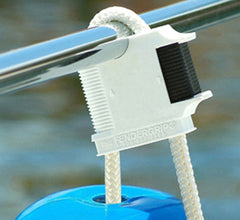 |
Fendergrip® makes fender adjustments a breeze, and installs in seconds to cleats, grab handles and rails of any size or shape. Gives you instant push button fender height adjustment plus a positive lock. |
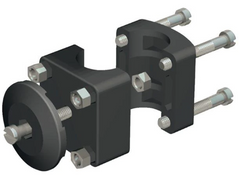 |
Rail Connectors to fix fender baskets to rail. |
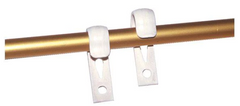 |
Fender Clips plastic clips for rails, UV protected, adjustable with lock system. |
 |
Fender Hooks chrome-plated brass, hook or eye model. |


